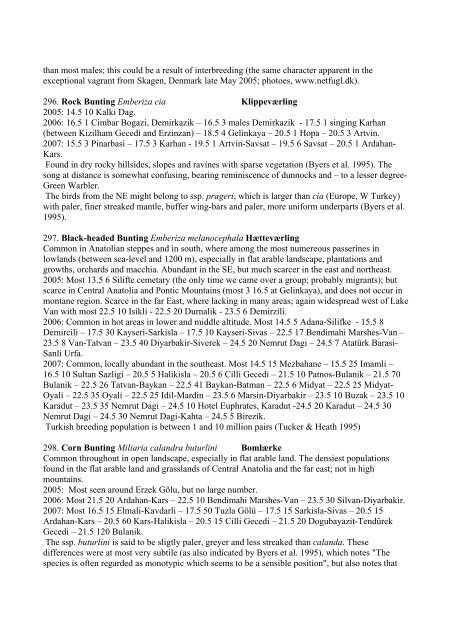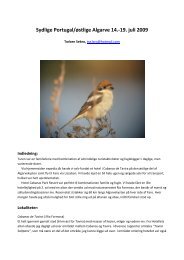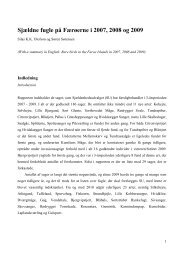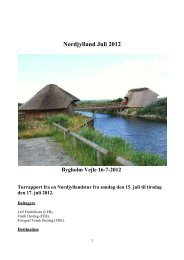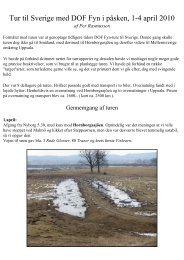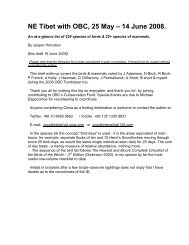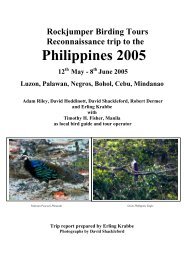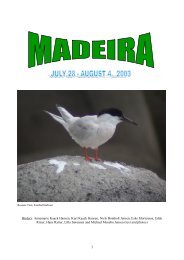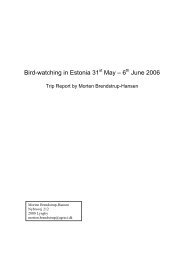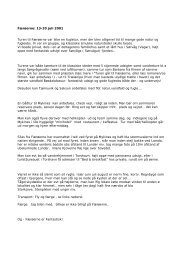TURKEY - a report from a birdwatching trip to Central ... - Netfugl.dk
TURKEY - a report from a birdwatching trip to Central ... - Netfugl.dk
TURKEY - a report from a birdwatching trip to Central ... - Netfugl.dk
Create successful ePaper yourself
Turn your PDF publications into a flip-book with our unique Google optimized e-Paper software.
than most males; this could be a result of interbreeding (the same character apparent in the<br />
exceptional vagrant <strong>from</strong> Skagen, Denmark late May 2005; pho<strong>to</strong>es, www.netfugl.<strong>dk</strong>).<br />
296. Rock Bunting Emberiza cia Klippeværling<br />
2005: 14.5 10 Kalki Dag.<br />
2006: 16.5 1 Cimbar Bogazi, Demirkazik – 16.5 3 males Demirkazik - 17.5 1 singing Karhan<br />
(between Kizilham Gecedi and Erzinzan) – 18.5 4 Gelinkaya – 20.5 1 Hopa – 20.5 3 Artvin.<br />
2007: 15.5 3 Pinarbasi – 17.5 3 Karhan - 19.5 1 Artvin-Savsat – 19.5 6 Savsat – 20.5 1 Ardahan-<br />
Kars.<br />
Found in dry rocky hillsides, slopes and ravines with sparse vegetation (Byers et al. 1995). The<br />
song at distance is somewhat confusing, bearing reminiscence of dunnocks and – <strong>to</strong> a lesser degree-<br />
Green Warbler.<br />
The birds <strong>from</strong> the NE might belong <strong>to</strong> ssp. prageri, which is larger than cia (Europe, W Turkey)<br />
with paler, finer streaked mantle, buffer wing-bars and paler, more uniform underparts (Byers et al.<br />
1995).<br />
297. Black-headed Bunting Emberiza melanocephala Hætteværling<br />
Common in Ana<strong>to</strong>lian steppes and in south, where among the most numereous passerines in<br />
lowlands (between sea-level and 1200 m), especially in flat arable landscape, plantations and<br />
growths, orchards and macchia. Abundant in the SE, but much scarcer in the east and northeast.<br />
2005: Most 13.5 6 Silifte cemetary (the only time we came over a group; probably migrants); but<br />
scarce in <strong>Central</strong> Ana<strong>to</strong>lia and Pontic Mountains (most 3 16.5 at Gelinkaya), and does not occur in<br />
montane region. Scarce in the far East, where lacking in many areas; again widespread west of Lake<br />
Van with most 22.5 10 Isikli - 22.5 20 Durnalik - 23.5 6 Demirzili.<br />
2006: Common in hot areas in lower and middle altitude. Most 14.5 5 Adana-Silifke - 15.5 8<br />
Demircili – 17.5 30 Kayseri-Sarkisla – 17.5 10 Kayseri-Sivas – 22.5 17 Bendimahi Marshes-Van –<br />
23.5 8 Van-Tatvan – 23.5 40 Diyarbakir-Siverek – 24.5 20 Nemrut Dagi – 24.5 7 Atatürk Barasi-<br />
Sanli Urfa.<br />
2007: Common, locally abundant in the southeast. Most 14.5 15 Mezbahane – 15.5 25 Imamli –<br />
16.5 10 Sultan Sazligi – 20.5 5 Halikisla – 20.5 6 Cilli Gecedi – 21.5 10 Patnos-Bulanik – 21.5 70<br />
Bulanik – 22.5 26 Tatvan-Baykan – 22.5 41 Baykan-Batman – 22.5 6 Midyat – 22.5 25 Midyat-<br />
Oyali – 22.5 35 Oyali – 22.5 25 Idil-Mardin – 23.5 6 Marsin-Diyarbakir – 23.5 10 Buzak – 23.5 10<br />
Karadut – 23.5 35 Nemrut Dagi – 24.5 10 Hotel Euphrates, Karadut -24.5 20 Karadut – 24.5 30<br />
Nemrut Dagi – 24.5 30 Nemrut Dagi-Kahta – 24.5 5 Birezik.<br />
Turkish breeding population is between 1 and 10 million pairs (Tucker & Heath 1995)<br />
298. Corn Bunting Miliaria calandra buturlini Bomlærke<br />
Common throughout in open landscape, especially in flat arable land. The densiest populations<br />
found in the flat arable land and grasslands of <strong>Central</strong> Ana<strong>to</strong>lia and the far east; not in high<br />
mountains.<br />
2005: Most seen around Erzek Gölu, but no large number.<br />
2006: Most 21.5 20 Ardahan-Kars – 22.5 10 Bendimahi Marshes-Van – 23.5 30 Silvan-Diyarbakir.<br />
2007: Most 16.5 15 Elmali-Kavdarli – 17.5 50 Tuzla Gölü – 17.5 15 Sarkisla-Sivas – 20.5 15<br />
Ardahan-Kars – 20.5 60 Kars-Halikisla – 20.5 15 Cilli Gecedi – 21.5 20 Dogubayazit-Tendürek<br />
Gecedi – 21.5 120 Bulanik.<br />
The ssp. buturlini is said <strong>to</strong> be sligtly paler, greyer and less streaked than calanda. These<br />
differences were at most very subtile (as also indicated by Byers et al. 1995), which notes "The<br />
species is often regarded as monotypic which seems <strong>to</strong> be a sensible position", but also notes that


